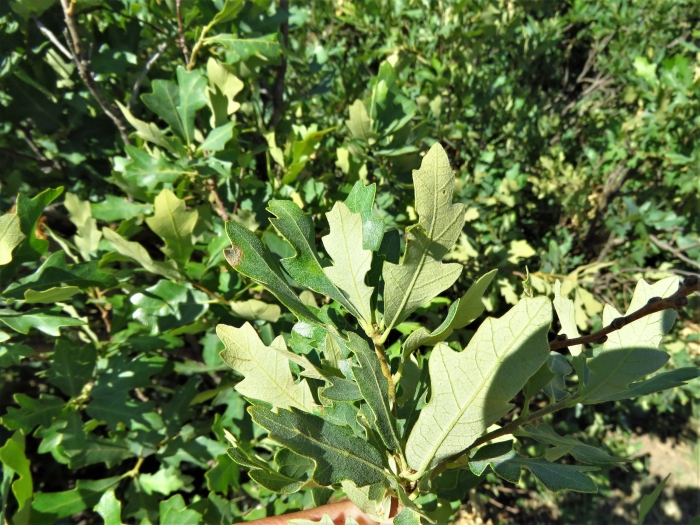Shinnery Oak
(Quercus havardii)
Shinnery Oak (Quercus havardii)
/
/

Annika Lindqvist
CC BY 4.0
Image By:
Annika Lindqvist
Recorded By:
Copyright:
CC BY 4.0
Copyright Notice:
Photo by: Annika Lindqvist | License Type: CC BY 4.0 | License URL: http://creativecommons.org/licenses/by/4.0/ | Rights Holder: Annika Lindqvist | Publisher: iNaturalist | Date Created: 2020-05-31T17:05:44-07:00 |
















































Estimated Native Range
Summary
Quercus havardii, commonly known as Shinnery Oak, is a deciduous, low-growing, thicket-forming shrub native to the sand dunes and sandy plains of the south-central United States, particularly in Texas, Oklahoma, and New Mexico. It typically reaches 1 to 2 meters (3-6 feet) in height and forms dense thickets. The shrub’s stems are often twisted or bent, contributing to its rugged appearance. The Shinnery Oak’s leaves are leathery, highly variable in shape, grey-green to olive-green with a lustrous upper surface, and whitish and densely hairy below. It produces inconspicuous flowers in the spring, followed by acorns that mature in the autumn and are an important food source for wildlife.
The Shinnery Oak is valued for its ability to stabilize sandy soils and prevent wind erosion, making it an excellent choice for restoration projects in arid regions. Its dense growth habit provides cover and food for diverse wildlife species. In cultivation, it is used for naturalistic plantings and as a windbreak. This oak is drought-tolerant and thrives with minimal water once established, preferring full sun to part shade and well-drained sandy soils. While it is generally disease-resistant, it can suffer from oak wilt, a serious fungal disease. Gardeners should be aware that its dense thickets can be difficult to remove if the plant becomes too aggressive in the landscape.CC BY-SA 4.0
The Shinnery Oak is valued for its ability to stabilize sandy soils and prevent wind erosion, making it an excellent choice for restoration projects in arid regions. Its dense growth habit provides cover and food for diverse wildlife species. In cultivation, it is used for naturalistic plantings and as a windbreak. This oak is drought-tolerant and thrives with minimal water once established, preferring full sun to part shade and well-drained sandy soils. While it is generally disease-resistant, it can suffer from oak wilt, a serious fungal disease. Gardeners should be aware that its dense thickets can be difficult to remove if the plant becomes too aggressive in the landscape.CC BY-SA 4.0
Plant Description
- Plant Type: Tree, Shrub
- Height: 3-6 feet
- Width: 3-5 feet
- Growth Rate: Slow
- Flower Color: N/A
- Flowering Season: Spring
- Leaf Retention: Deciduous
Growth Requirements
- Sun: Full Sun, Part Shade
- Water: Low
- Drainage: Fast
Common Uses
Bee Garden, Bird Garden, Butterfly Garden, Low Maintenance, Rabbit Resistant
Natural Habitat
Sand dunes and sandy plains of the south-central United States, particularly in Texas, Oklahoma, and New Mexico
Other Names
Common Names: Shinnery Oak, Shin Oak
Scientific Names: , Quercus havardii, Quercus harvardii, Quercus harvardii var. tuckeri, Quercus harvardii var. harvardii, Quercus havardii var. havardii,
GBIF Accepted Name: Quercus havardii Rydb.